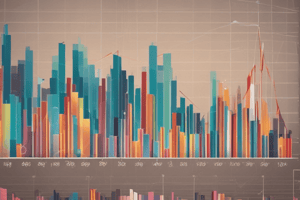Podcast
Questions and Answers
Which of the following is NOT an essential step when interpreting bar graphs?
Which of the following is NOT an essential step when interpreting bar graphs?
- Consider any groupings or stacking of bars
- Examine proportions of subgroups within larger groups
- Use the scale on the y-axis to determine magnitudes
- Calculate the standard deviation for each group (correct)
What is a key advantage of using bar graphs?
What is a key advantage of using bar graphs?
- They can calculate correlation coefficients
- They can reveal causation between variables
- They can perform hypothesis testing
- They can identify relationships between categorical variables (correct)
Which of the following statements about bar graphs is FALSE?
Which of the following statements about bar graphs is FALSE?
- They provide an effective way to visualize data across categories
- They can compare summary statistics across multiple categories
- They can highlight patterns within categorical variables
- They should only be used with continuous numerical data (correct)
What is an important consideration when interpreting bar graphs?
What is an important consideration when interpreting bar graphs?
Which type of bar graph allows for the comparison of proportions within groups?
Which type of bar graph allows for the comparison of proportions within groups?
Flashcards are hidden until you start studying
Study Notes
Bar Graphs
Bar graphs, also known as bar charts, are a type of graph commonly used in visualizing data. They are particularly useful in comparing summary statistics between different categories. Each bar in a bar graph represents a discrete category, and the height of the bar indicates the magnitude of the associated variable.
Types of Bar Graphs
There are several types of bar graphs, each serving different purposes. Some common ones include:
-
Simple Bar Graphs: These are basic bar graphs where each bar represents a single category. They are suitable for comparing counts, sums, means, or standard deviations between categories.
-
Clustered Bar Graphs: In these graphs, bars are grouped together according to one categorical variable. This allows for comparison of the same variable across different levels of another variable.
-
Stacked Bar Graphs: Here, bars are stacked vertically so that each category is represented by one or more bars. This type of graph is useful when examining how components of a single variable add up in different categories.
Interpreting Bar Graphs
When interpreting bar graphs, follow these steps:
-
Identify the Variables: Determine what variables are represented by the axes and what each bar represents.
-
Compare Bars: Assess differences in height among bars within the same graph. Longer bars indicate higher values for the associated category.
-
Consider Groupings: If applicable, take into account any groupings or stacking of bars and consider how this affects interpretation.
-
Examine Proportions: Look at the proportions of subgroups within larger groups and observe changes in proportions between different groups.
-
Use Scale: Refer to the scale on the y-axis to determine actual differences between groups in terms of magnitude.
Key Points for Using Bar Graphs
Bar graphs can help identify relationships between categorical variables and highlight patterns within them. They are particularly useful when comparing summary statistics between multiple categories or understanding relationships between categorical variables. However, remember that statistical significance should also be considered through hypothesis tests.
In conclusion, bar graphs provide an effective way to compare and visualize data across different categories, offering valuable insights into patterns and trends. With careful interpretation, they can reveal important information about any dataset they represent.
Studying That Suits You
Use AI to generate personalized quizzes and flashcards to suit your learning preferences.




